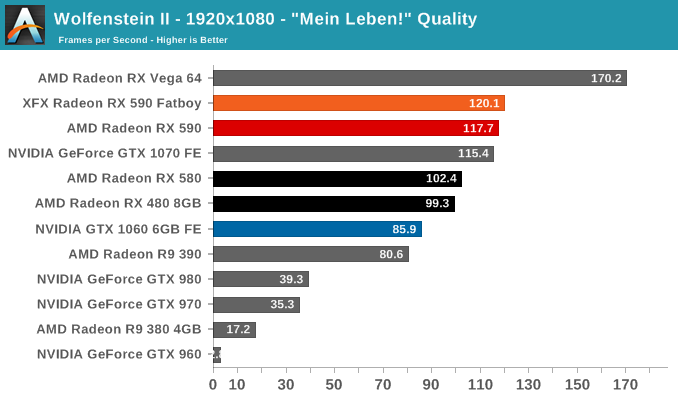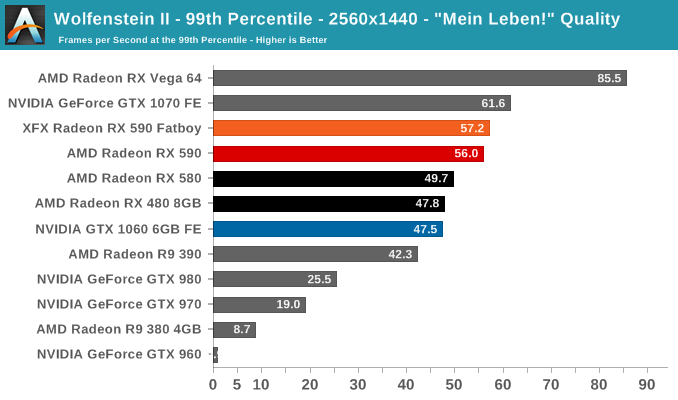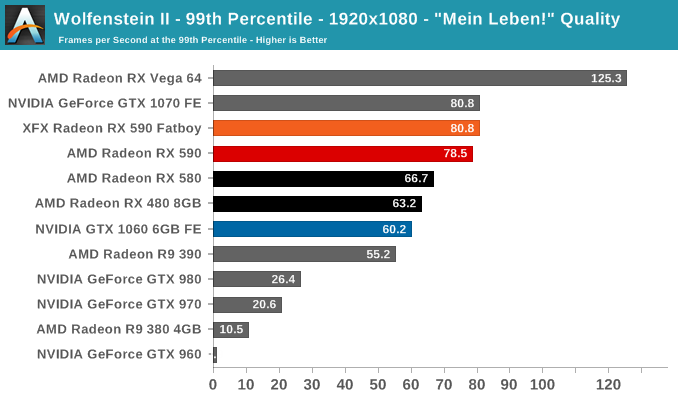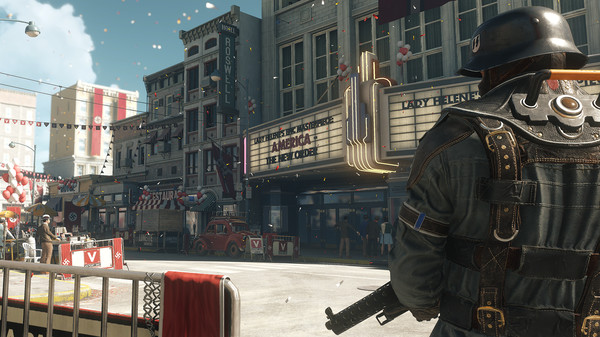The AMD Radeon RX 590 Review, feat. XFX & PowerColor: Polaris Returns (Again)
by Nate Oh on November 15, 2018 9:00 AM ESTWolfenstein II: The New Colossus (Vulkan)
id Software is popularly known for a few games involving shooting stuff until it dies, just with different 'stuff' for each one: Nazis, demons, or other players while scorning the laws of physics. Wolfenstein II is the latest of the first, the sequel of a modern reboot series developed by MachineGames and built on id Tech 6. While the tone is significantly less pulpy nowadays, the game is still a frenetic FPS at heart, succeeding DOOM as a modern Vulkan flagship title and arriving as a pure Vullkan implementation rather than the originally OpenGL DOOM.
Featuring a Nazi-occupied America of 1961, Wolfenstein II is lushly designed yet not oppressively intensive on the hardware, something that goes well with its pace of action that emerge suddenly from a level design flush with alternate historical details.
The highest quality preset, "Mein leben!", was used. Wolfenstein II also features Vega-centric GPU Culling and Rapid Packed Math, as well as Radeon-centric Deferred Rendering; in accordance with the preset, neither GPU Culling nor Deferred Rendering was enabled.


For a game that scales well and enables high framerates with minimal CPU bottleneck, Wolfenstein II has the tradeoff of needing more than 4GB at highest quality settings. This even applies to 1080p! Limited VRAM truly bottlenecks the GPU here, where a card like the enthusiast-grade GTX 980 (4GB) would typically hold its own against the mainstream-grade GTX 1060 6GB.
And so NVIDIA's historical stinginess with video memory hurts them hard here, hammering Maxwell 2 performance as only the GTX 980 Ti and above have more than 4GB of VRAM. The 2GB GTX 960 is reduced to a stuttering fit. Meanwhile, the Hawaii refresh R9 390, whose 8GB memory configuration upgrade was laughed at in 2015, has the last laugh in Wolfenstein II.
Usually, games that devour excessive VRAM have no real reason to do so other than being poor console ports. But the way Wolfenstein II runs on Vulkan has continually impressed me on many levels. It removes so much of the CPU bottleneck and truly enables usage of ultra high refresh rates at any resolution and for a bonafide AA/AAA title. The equally high 99th percentiles are perfect for VR purposes or silky-smooth 'just works' gaming, because regardless Wolfenstein II is a good-looking game. The game and engine also takes a liking to Turing, Vega, and Polaris based cards. If the VRAM consumption is not merely a correlation or coincidence, then that's a perfectly acceptable tradeoff to me.
The spare performance leaves multiple opportunities, too, and as a naive example I wonder if it'd be possible to implement something like DXR accelerated real-time raytracing at 4Kp60.













136 Comments
View All Comments
Opencg - Thursday, November 15, 2018 - link
Its just a gap filler. It will help them make money from people wanting to get good performance at that price but... we're still waiting for the serious contenders. Vega refresh will be a little more toward the high end but... navi is where amd could potentially shift the market. RTX means you pay more for less performance outside rtx games. Navi is the opposite you pay less and get more. We need navi to function well and I believe amd can do it.neblogai - Thursday, November 15, 2018 - link
Is is not a gap filler. It is only there, because overproduction of P20 needs to be sold out first. Naturally- P30 should be a replacement of P20, at same price, with minimal investment by MAD or partners.eva02langley - Thursday, November 15, 2018 - link
Polaris is selling well, Vega, not so much beside mining. In Canada, the price are still having a huge price tag because the supply is just so low.Allan_Hundeboll - Thursday, November 15, 2018 - link
I am surprised a boost frequency increase of 15% nets 12% overall performance. Maybe Polaris isn't as starved for memory bandwidth, as people seem to think. Or AMD made other improvements besides the increased frequency...?mapesdhs - Thursday, November 15, 2018 - link
Frequency increases rarely produce linear performance gains, not when there are so many other aspects of a system that impact what's happening (main CPU, API, game engine, etc.)Allan_Hundeboll - Thursday, November 15, 2018 - link
Yes that is why I'm surprised 15% increase on the core frequency -without any increase of the Vram frequency, would result in 12% overall performance increase. Especially considering the "original Polaris" rx480 was configured with 1266Mhz core boost frequency and 2000Mhz Vram.If AMD figured 1266/2000MHz was near the sweet spot balance between core/mem speed then 1545/2000 would be severly starved for memory bandwidth.
So I'm wondering if 2000MHz memory speed was kind of wasted on the rx480? Or did AMD tighten the Vram timings on this new 590? Or maybe the near linear increase in performance is due to the higher tdp allowing the rx590 to sustain the boost clock while the 480 would throttle to base core frequency of 1120MHz?
SlowSpyder - Thursday, November 15, 2018 - link
Where is 7nm Vega??mapesdhs - Thursday, November 15, 2018 - link
Never going to happen, because gamers won't buy it.https://www.youtube.com/watch?v=guK2XoFbPFw
https://www.youtube.com/watch?v=USMlET3L7mA
Cyborg997 - Thursday, November 15, 2018 - link
Summer 2019 or late 2019. Definitely soon rtx fighter.schujj07 - Thursday, November 15, 2018 - link
The most surprising thing to me is just how good RX480 is when you look at the benchmarks. When it launched it was as fast as the GTX970, now it is faster than then GTX980 just due to drivers and newer games being able to use its resources better.